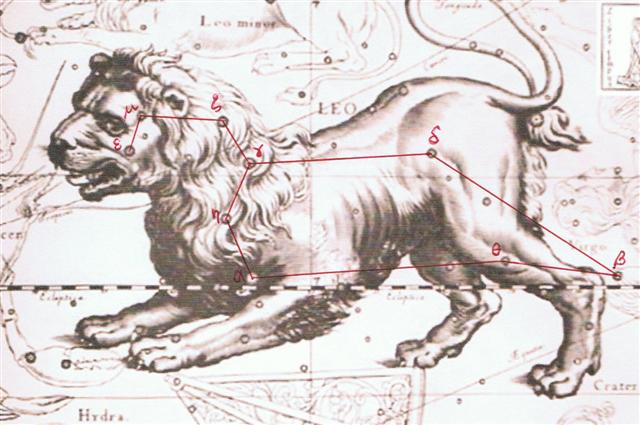Below I have added red for those RA distances with are without fractions:
The name Alterf used for λ Leonis means the 'glance' of the 'eye': ... Alterf [λ] is from Al Tarf, the name for the 7th manzil, which it formed with ξ Cancri. The word has generally been rendered the Glance, i.e. of the Lion's eye, although on modern maps the star lies in the open mouth, where Ptolemy located it. But it also had the secondary meaning of the Extremity, still more appropriate here, and so understood by Ideler ... As to 'Dschuba', 'Azzubra', and 'Assarfa', I think also these 3 stars belong in Leo: ... Smyth wrote of this that it [γ Leonis alias 'Dschuba'] has been improperly called Algieba, from Al jeb-bah, the forehead; for no representation of the Lion, which I have examined, will justify that position, - a well-founded criticism, although as, after Regulus, it is the brightest member of the manzil Al Jabbah, it may have taken the latter's title. The star, however, is on the Lion's mane, the Latin word for which, Juba, distinctly appeared for γ with Bayer, Riccoli, and Flamsteed. Hence it is not at all unlikely that Algieba, - also written Algeiba, - is from the Latin, Arabicised either by error in translation or by design ... ... Zosma [δ Leonis] and Zozma are from ζωσμα, an occasional form of ζωμα, the Girdle, found in the Persian Tables; but its propriety as a stellar title is doubtful, for the star is on the Lion's rump, near the tail. Ulug Beg very correctly termed it Al Thar al Asad, the Lion's Back, which has become Duhr and Dhur of modern catalogues. With θ, on the hind quarter, it constituted the 9th manzil, Al Zubrah, the Mane, and itself bears this name as Zubra, - strange titles for star and station so far away from that feature of the animal. δ and θ also were Al Kāhil al Asad, the Space between the Shoulders of the Lion; and Al Harātān, sometimes transcribed as Chortan, and translated the Two Little Ribs, or the two Khurt, or Holes, penetrating into the interior of the Lion; but all these seem as inapplicable as are the other titles. In India they marked the corresponding nakshatra, Pūrva Phalgunī, δ being the junction star between the two Phalgunī asterisms ... θ in the manzil Al Zubrah, shares with δ the title Al Harātān, Al Bīrūnī saying that 'when they rise Suhail is seen in Al Izak', - wherever this may be. The Century Cyclopedia gives Chort as the individual name, from the combined title ...
The Tail of the Lion (Deneb-ola, my yoke: 'End of Life', β Leonis) surely was a corner in time (though not at the end of the tail as Hevelius has drawn the figure) and I should therefore take the opportunity to quote more extensively from Allen about this fundamental star, which as far as I can remember it not has been done earlier: "Denebola - sometimes Deneb - is the modern name for this star, abbreviated from Al Dhanab al Asad, the Lion's Tail, the Greek Άλκαία; Bayer gave it as Denebalecid and Denebaleced; Chilmead, as Deneb Alased; and Schickard, as Dhanbol-asadi. Riccioli omitted the first syllable of the original, and called the star Nebolellesed, Nebollassid 'of the Nubian astrologers', and Alazet, 'apud Azophi', his title for Al Sufi. Elsewhere it is Nebulasit and Alesit; the Alphonsine Tables have Denebalezeth and the very appropriate Dafira, from the similar Arabic term for the tuft of coarse hair at the end of the tail in which the star lies. [Hevelius has 93 Leonis at this place.] Proctor cited Al Aktāb al Asad, the viscera of the Lion, or Al Katab, a Small Saddle; inappropriate names, Ideler said, and inferred that they should be Al Kalb, which in the course of time might have wandered here from Regulus, the genuine Kalb, or Heart, of the Lion. It marked the 10th manzil, Al Sarfah, the Changer, i.e. of the weather, given by Ulug Beg as the star's individual title; and Al Bīrūnī wrote of it: 'The heat turns away when it rises, and the cold turns away when it disappears'. Chilmead cited Asumpha, which he attributed to Alfraganus; Baily called this Serpha; and Hyde changed it to Mutatrix." My guess is that 'Assarfa' is a variant of 'Al Sarfah' ('Serpha'). Any remaining doubt should disappear when we can read: "Nearly the same stars [as in Hindu descriptions of Leo] were included in the 8th, 9th, and 10th manazil of Arabia as Al Jabhah, the Forehead; Al Zubrah, the Mane; and Al Sarfah, the Turn." (Allen) | |||||||||||||||||||||||||||||||||||||||||||||||||||||||||||||||||||||||||||||||||||||||||||||||
